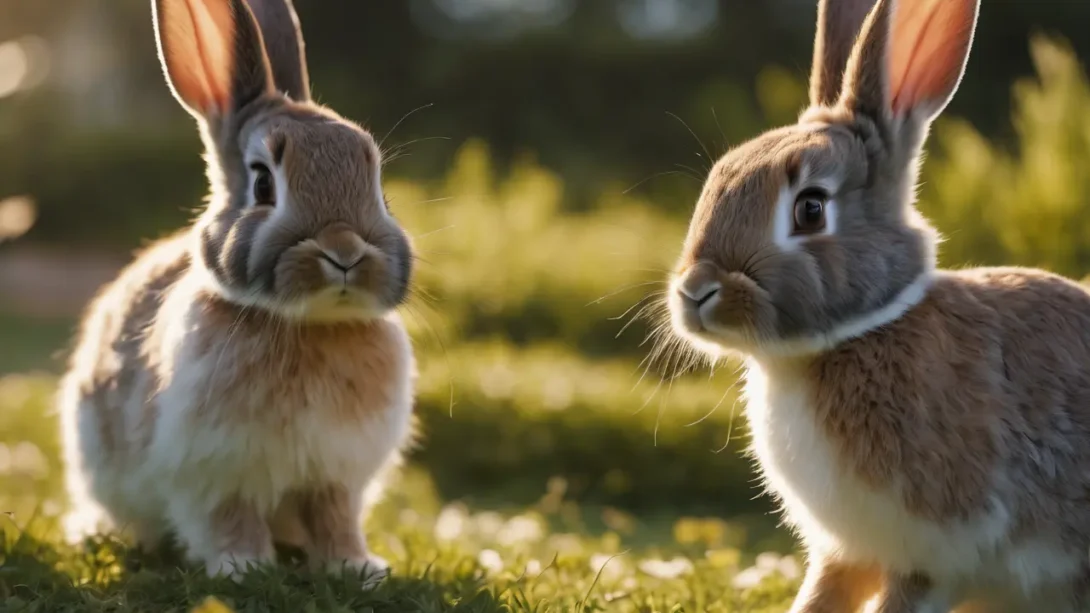Attracting rabbits to your garden or property can offer a unique opportunity to connect with the natural world right in your own backyard. Whether you’re interested in wildlife photography, creating a more dynamic ecosystem, or simply enjoy watching these charming creatures, understanding how to make your space inviting to rabbits is key. This guide will explore the essential steps to attracting rabbits, focusing on their behavior, dietary preferences, and habitat needs.
Rabbits
To attract rabbits effectively, it’s important to start with a basic understanding of these animals. In North America, the Eastern Cottontail is among the most common species and is likely the rabbit most people are aiming to attract. Rabbits are crepuscular, meaning they are most active during dawn and dusk, and they have a diet that primarily consists of grasses, clover, wildflowers, and some vegetables.
Rabbits prefer habitats that offer a blend of open spaces for feeding and dense cover for hiding and protection from predators. They are also territorial and will establish a home range close to reliable food sources and shelter. By mimicking these conditions, you can make your garden more appealing to rabbits.
Creating a Rabbit-Friendly Habitat
Food Sources
One of the most effective ways to attract rabbits is by providing them with a variety of food they enjoy. Planting a selection of grasses, clover, and flowers such as marigolds and pansies can draw rabbits to your yard. Here are some tips for creating an enticing menu for your furry guests:
- Plant Diversity: Cultivate a mix of rabbit-friendly vegetation. Native plants are often a good choice as they’re not only appealing to rabbits but also support local ecosystems.
- Vegetable Offerings: If you’re a gardener, consider planting a few extra vegetables on the periphery of your garden specifically for rabbits. Carrots, lettuce, and spinach are favorites.
- Organic Practices: To ensure the safety of both rabbits and the environment, avoid using pesticides or chemical fertilizers in your garden.
Water Sources
Like all animals, rabbits need access to fresh water. Adding a water feature to your garden can be as simple as placing shallow dishes or birdbaths at ground level. Here are some considerations for providing water:
- Accessibility: Ensure that water sources are easily accessible to rabbits but placed in locations that offer some cover to protect them from predators.
- Maintenance: Regularly clean and refill water sources to keep them safe and inviting for rabbits and other wildlife.
Creating a habitat that meets the basic needs of rabbits for food and water is a critical first step in attracting them to your property. By carefully selecting plants and providing a reliable water source, you can encourage these delightful creatures to visit and make your garden a part of their territory.
Shelter and Protection
Creating a safe and welcoming environment is essential for attracting and keeping rabbits in your garden. A crucial part of this is providing ample shelter and protection from predators.
Natural Cover
Rabbits rely on natural cover for safety from predators and harsh weather conditions. Incorporating elements of their natural habitat into your garden can encourage them to stay:
- Dense Plantings: Bushes, shrubs, and thickets offer excellent hiding spots. Plants like blackberry bushes not only provide cover but also a food source.
- Low-Lying Foliage: Ground covers and low-lying foliage give rabbits quick escape routes and shelter. Planting areas of dense ground cover can mimic the underbrush of their natural habitat.
Artificial Shelters
In addition to natural plant cover, artificial shelters can also provide safe havens for rabbits:
- Brush Piles: A simple pile of branches and leaves can offer an immediate shelter option for rabbits.
- Burrow Substitutes: Small, enclosed spaces, such as overturned boxes with entrance holes or commercially available small animal shelters, can mimic natural burrows.
Safety Measures
Ensuring the safety of rabbits visiting your garden means taking measures to protect them from common predators and human-made hazards.
Predator Deterrence
Keeping rabbits safe from predators such as cats, dogs, and wild animals is essential:
- Fencing: Proper fencing can deter many predators. A fence that is at least 2 feet high and buried 6-10 inches below the ground can prevent most predators from entering your garden.
- Natural Deterrents: Planting certain types of vegetation that predators dislike can also serve as a deterrent.
Chemical-Free Zone
To create a truly rabbit-friendly environment, it’s crucial to maintain a garden free from chemicals:
- Avoid Pesticides and Herbicides: Chemicals used to kill weeds or pests can be harmful or even lethal to rabbits. Opt for natural pest control methods instead.
- Organic Fertilizers: If fertilization is necessary, choose organic options that are safe for wildlife.
Encouraging Reproduction
While attracting rabbits to your garden can be rewarding, it’s also important to consider the implications of encouraging them to reproduce on your property:
- Nesting Sites: Providing materials such as straw or grass clippings in secluded areas of your garden can encourage rabbits to build nests.
- Population Management: Be mindful of the potential for rabbit populations to grow rapidly. While rabbits can be delightful visitors, an overabundance may lead to issues with overgrazing and damage to your garden.
Attracting rabbits to your garden involves more than just providing food and water; it requires creating a safe, sheltered environment that mimics their natural habitat while protecting them from predators and harmful chemicals. By carefully planning your garden to include these elements, you can enjoy the presence of rabbits while ensuring their safety and well-being.
Community Engagement and Education
Attracting rabbits to your garden not only enhances your personal enjoyment of your outdoor space but also offers opportunities for community engagement and education. Sharing the joy and knowledge of local wildlife with family, friends, and neighbors can foster a greater appreciation for nature and the importance of ecological balance.
Educational Opportunities
- Wildlife Conservation: Use the presence of rabbits as a teaching moment about the importance of wildlife conservation and habitat protection. This can be especially impactful for children, instilling a sense of responsibility towards nature.
- Gardening for Biodiversity: Educate others on how cultivating a garden that supports wildlife, like rabbits, contributes to biodiversity, benefiting the environment as a whole.
Observation and Photography
- Best Practices: Offer tips on the best times of day for rabbit activity (dawn and dusk) and how to quietly observe without disturbing them. This can be valuable for wildlife enthusiasts and photographers alike.
- Ethical Wildlife Photography: Share guidelines on ethical wildlife photography, emphasizing the importance of not stressing the animals for the sake of a photo.
Conclusion
Creating an inviting environment for rabbits in your garden requires thoughtful consideration of their needs for food, water, shelter, and safety. By implementing the strategies outlined in this article, you can enjoy the presence of these charming creatures while contributing positively to your local ecosystem. It’s important to remember that attracting wildlife is a responsibility as much as it is a pleasure, requiring ongoing efforts to ensure the health and safety of both the animals and your property.
Furthermore, engaging with your community about the benefits and joys of attracting rabbits can amplify the positive impact of your efforts, spreading awareness and fostering a collective appreciation for nature. As you observe and enjoy the rabbits that come to visit, you’ll find that the rewards of creating a wildlife-friendly garden extend far beyond the simple pleasure of watching these delightful animals; they also include the satisfaction of contributing to wildlife conservation and ecological diversity.
In the end, the key to successfully attracting rabbits—and enjoying their presence responsibly—lies in maintaining a balance between providing for their needs and managing your garden’s ecosystem sustainably. With patience, care, and a little bit of knowledge, your garden can become a haven for rabbits and a source of endless fascination and learning for you and your community.



